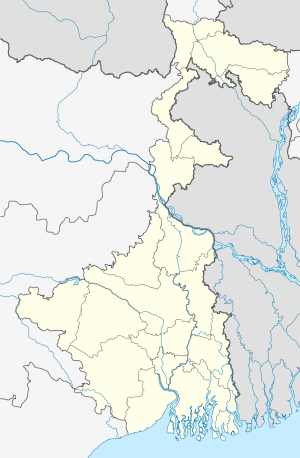Dankuni
| Dankuni ডানকুনি | |
|---|---|
| Town | |
 Dankuni Location in West Bengal, India | |
| Coordinates: 22°49′N 88°14′E / 22.81°N 88.23°ECoordinates: 22°49′N 88°14′E / 22.81°N 88.23°E | |
| Country |
|
| State | West Bengal |
| District | Hooghly |
| Nearest City | Serampore |
| Population (2011) | |
| • Total | 249,840 |
| Languages | |
| • Official | Bengali, English |
| Time zone | IST (UTC+5:30) |
Dankuni is a fast-growing industrial township near Kolkata, India. The town is part of the Hooghly District and under Serampore/Srirampore subdivision , in the state of West Bengal. It is a part of the area covered by Kolkata Metropolitan Development Authority.[1]
It is well-connected by road or trains from both Howrah Station and Sealdah Station. Dankuni Junction rail station is 15 km (9.3 mi) from Howrah Station. The nearest airport is the Netaji Subhas Chandra Bose International Airport located at Dum Dum, 20 km (12 mi) from Dankuni.
Major industries like "Mother Dairy","Coca Cola", "Dankuni Coal Complex Ltd", "Food Corporation of India", "Anmol Biscuits Ltd." and many other have been established. The town has witnessed great changes and developments in the recent years.
Transport
Both NH 2 and NH 6 terminate at Dankuni.[2] The Palsit-Dankuni section of NH 2 is also referred to as Durgapur Expressway. Other major arteries meeting at Dankuni are Belghoria Expressway connecting to NH 34 and the Dankuni-Memari Delhi Road. Presently, a Locomotive Factory for Railways under construction.
Dankuni railway station is located on the Howrah-Bardhaman chord line, which was constructed in 1917. The Calcutta Chord from Dum Dum to Dankuni over the Willingdon Bridge (renamed Vivekananda Bridge) was opened in 1932.[3] It is part of the Kolkata Suburban Railway system. Already, there is a growing presence of freight and wagon movements around Dankuni Railway Station, which is important as it connects Eastern Railway with South Eastern Railway with a link line. Dankuni, has a fast-growing freight yard, where goods traffic is moved, sorted, and packed to deliver at other destinations.
In the future, Dankuni is believed to play a significant role because it will be the endpoint of the Ludhiana-Dankuni leg of the Dedicated Freight Corridor that is being built by Indian Railways.
Bus Route
Private Bus Routes
- 26 Bonhooghly – Chapadanga
- 26C Bonhooghly – Jagatballavpur
- 40 Serampore – Birshibpur
- 51 Howrah Station – Pardankuni
- DN46 Dankuni Housing Estate – Salt Lake Karunamoyee
CTC Bus Routes
- C23 Park Circus – Dankuni
- E14 Esplanade – Furfura Shariff
WBSTC Franchise Bus
- Dankuni – Kamalgazi
STA Routes
- Haroa – Dankuni
Bus Route Without Number
Demographics
In the 2011 census, Dankuni Urban Agglomeration had a population of 249,840, out of which 128,139 were males and 121,701 were females. The 0–6 years population was 22,956. Effective literacy rate for the 7+ population was 85.69 per cent.[4]
Education
Dankuni is home to Shree Ramkrishna Sishu Tirtha High School, Patha Bhavan, The Methodist School,Ramkrishna Vidyashram, Garalgacha High School, The Abacus Central School etc.
Economy
Township project
A new township is being developed at Dankuni. According to the Kolkata Metropolitan Development Authority (KMDA) the project area is 4,846 acres (19.61 km2) of which 4,069 acres (16.47 km2) is township area and 777 acres (3.14 km2) is earmarked as industrial area. The project area covers 20 mouzas (villages) – 5 full and 15 part, spread across four police stations, namely Dankuni, Chanditala, Singur and Serampore. Important railway stations in the project area are Gobra, Janai Road and Begampur, apart from the important station at Dankuni itself, all on the Howrah-Bardhaman chord. Important road corridors cutting across the project area are Durgapur Expressway (NH2), Delhi Road, Naity Road and Serampore-Siakhala Road.[5][6] The township is being developed by DLF.[7] Once the ongoing work on the second Vivekananda Setu (across the Hooghly River) and the Belghoria Expressway through Nivedita Bridge is completed Dum Dum airport will be 20–25 minutes from Dankuni. Usha Martin School is new project in Dankuni.
References
- ↑ "Base Map of Kolkata Metropolitan area". Kolkata Metropolitan Development Authority. Retrieved 2007-09-03.
- ↑ "Completed Stretches on NH2 (Delhi-Kolkata)". Status : 31st Aug , 2005. National Highways Authority of India. Retrieved 2009-01-19.
- ↑ Chaudhuri, Sukanta, The Railway Comes to Calcutta, in Calcutta, the Living City, Vol. I, edited by Sukanta Chaudhuri, p. 239, Oxford University Press, ISBN 978-0-19-563696-3.
- ↑ "Urban Agglomerations/Cities having population 1 lakh and above" (PDF). Provisional Population Totals, Census of India 2011. Retrieved 2011-10-21.
- ↑ KMDA website
- ↑ Project Map – KMDA
- ↑ Google satellite view